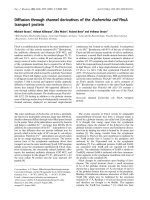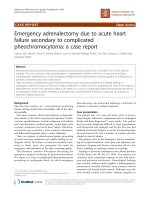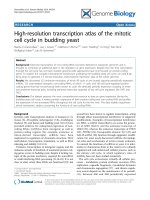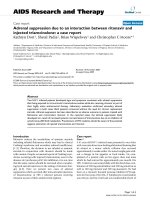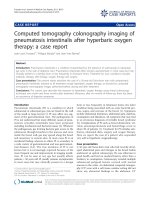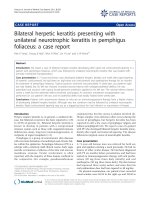Báo cáo y học: "Unusual clear cell tumors of the jaws – clinical and histopathological considerations: A case report" docx
Bạn đang xem bản rút gọn của tài liệu. Xem và tải ngay bản đầy đủ của tài liệu tại đây (768.56 KB, 3 trang )
BioMed Central
Page 1 of 3
(page number not for citation purposes)
Journal of Medical Case Reports
Open Access
Case report
Unusual clear cell tumors of the jaws – clinical and histopathological
considerations: A case report
Giulio Gasparini*
1
, Roberto Boniello
1
, Alessandro Moro
1
,
Francesco Federico
2
, Federica Castri
2
and Sandro Pelo
1
Address:
1
Maxillo-Facial Surgery, Catholic University Medical School, Rome, Italy and
2
Department of Pathology, Catholic University Medical
School, Rome, Italy
Email: Giulio Gasparini* - ; Roberto Boniello - ; Alessandro Moro - ;
Francesco Federico - ; Federica Castri - ; Sandro Pelo -
* Corresponding author
Abstract
Introduction: Clear cell neoplasms of the jaw are very infrequent and a review of the literature
reports only isolated cases of metastatic renal clear cell carcinoma of the jaw.
Case presentation: A 68-year-old man presented with an osteolytic lesion of the left
hemimandible. The first diagnostic hypothesis was a third molar follicular cyst. Surgical treatment
consisted of enucleating the lesion preserving the alveolar nerve and extracting of the retained
tooth. Unexpectedly, the lesion presented as a solid.
Conclusion: The authors report a case of a clear cell neoplasm involving the jaw in which
histopathological exam presented an indeterminate histology. The histological characteristics of
this tumor make it unique in the international literature.
Introduction
Clear cell neoplasms of the jaw are very rare and a review
of the literature reports only isolated cases of metastatic
renal clear cell carcinoma of the jaw [1-3]. In the present
work, we report a case of a clear cell neoplasm involving
the jaw in which histopathological exam presented an
indeterminate histology. The histological characteristics
of this tumor make it unique in the international litera-
ture.
Case presentation
A 68-year-old man presented to our center for treatment
of an osteolytic lesion of the left hemimandible. The
patient was completely asymptomatic and became aware
of the lesion following a panoramic radiography. The
lesion had spread into the linguo-vestibular thickness of
the left hemimandible from the second premolar to the
impacted third molar. Upon panoramic (Fig. 1) and com-
puted tomography (CT) DentaScan investigation, the
osteolytic lesion was seen to involve the first and second
molar apex with amputation of the mesial root apex of the
first molar. In spite of this, the teeth maintained pulp
vitality. The lesion had clear edges and had eroded the lin-
gual cortex.
The mandibular canal appeared to be eroded by the
lesion, such that the alveolar nerve was circumscribed,
even though the patient did not refer paresthesia. No
intraoral or extraoral swelling was present.
Published: 1 September 2008
Journal of Medical Case Reports 2008, 2:290 doi:10.1186/1752-1947-2-290
Received: 5 January 2008
Accepted: 1 September 2008
This article is available from: />© 2008 Gasparini et al; licensee BioMed Central Ltd.
This is an Open Access article distributed under the terms of the Creative Commons Attribution License ( />),
which permits unrestricted use, distribution, and reproduction in any medium, provided the original work is properly cited.
Journal of Medical Case Reports 2008, 2:290 />Page 2 of 3
(page number not for citation purposes)
The first diagnostic hypothesis was a third molar follicular
cyst. A biopsy was not taken. Surgical treatment consisted
of enucleating the lesion preserving the alveolar nerve and
extracting the wisdom tooth. Unexpectedly, the lesion
presented as a solid, sheet-like mass. At 6 months after
resection, all teeth involved maintained vitality.
Histopathological considerations
The histological specimen was sent to the Department of
Pathology, Brigham and Women's Hospital and Harvard
Medical School, Boston, USA for additional consultation.
The lesion was classified as a clear cell tumor of undefined
origin. It appeared as a grayish-white soft mass with a
diameter of 3.8 cm. The tumor was composed of a monot-
onous, sheet-like proliferation of uniform cells having a
clear cytoplasm and small nuclei; neither atypia nor pleo-
morphism could be detected and the mitotic index was
within normal limits (2 mitoses/50 HPF).
The possibility of a rare intraosseous form of meningioma
[4] was considered, as these neoplasms can assume differ-
ent aspects. Immunostaining, however, did not substanti-
ate this hypothesis. Ca 19.9, CD99, EMA and S100, which
are positive in meningioma in 100%, 93%, 83%, 22%
cases, respectively, were negative. However, the negativity
for PanKeratin, HMB45 and LCA ruled out the possibility
of a well differentiated epithelial, melanocytic or lym-
phocytic neoplasm, respectively. Desmin, CD68, SMA,
GFAP, HLA-DR, CEA, C-erbB-2 and C-kit also stained neg-
ative. The only immunopositivity was for Vimentin (Figs.
2, 3).
The possibility of a metastatic renal lesion was considered,
but both total-body CT scan and magnetic resonance were
negative. A specimen was sent to an international special-
ist who also could not identify the origin of this neo-
plasm, and concluded that it should be considered an
'unclassified clear cell neoplasm'. The clinical course was
to be carefully followed and a wait-and-see policy was
adopted since no overt morphologic signs of malignancy
were present.
Discussion and conclusion
Clear cell neoplasms of the jaw are very rare. In a review
of the literature, only isolated cases of metastatic renal
clear cell carcinoma of the jaw have been described [1-3].
Pre-operative panoramic radiographyFigure 1
Pre-operative panoramic radiography.
Histological viewFigure 2
Histological view. 10× H&E – proliferation of uniform and
monomorphic cells with small nuclei and clear cytoplasm; no
atypia and no mitosis.
Publish with BioMed Central and every
scientist can read your work free of charge
"BioMed Central will be the most significant development for
disseminating the results of biomedical research in our lifetime."
Sir Paul Nurse, Cancer Research UK
Your research papers will be:
available free of charge to the entire biomedical community
peer reviewed and published immediately upon acceptance
cited in PubMed and archived on PubMed Central
yours — you keep the copyright
Submit your manuscript here:
/>BioMedcentral
Journal of Medical Case Reports 2008, 2:290 />Page 3 of 3
(page number not for citation purposes)
In the maxillo-facial area, clear cell odontogenic tumors
have also been documented that are potentially aggressive
and capable of multiple local recurrences and both loco-
regional and distant metastases. Management of this type
of tumor should include wide en bloc resection and long-
term follow-up [4]. Moreover, clear cells can be histologi-
cally present in ameloblastoma [5] and in rare intraos-
seous forms of meningioma [6] and might be considered
in differential diagnosis of a jaw tumor.
In this patient, immunohistopathological exam presented
an ambiguous pattern that did not permit a definitive
diagnosis. Long-term follow-up will include clinical
examination at 6-month intervals. In the follow-up, we
decided to use a wait-and-see policy.
As this is an unidentifiable kind of neoplasm, it might rep-
resent a new type of lesion. We suggest considering this
lesion as malignant, as long as it is impossible to find evi-
dence of its benignity. That is why we highly recommend
a follow-up with physical exam every 3 months in the first
year, every 2–4 months during the second year, every 4–6
months from the third to the fifth year and every 6–12
months from the fifth year. The radiological exams should
consist of CT of the maxillo-facial complex and neck with
and without contrast agent every 6 months during the first
year, alternating with echography of the neck every 3
months for the first year. From the third year, one echog-
raphy every 6 months and CT every year [7]. We suggest
treating the lesion as a malignant one in case of relapse
with bone and soft tissue resection. For 'relapse', we mean
every kind of lesion occurring next to the treated areas or
every lymphnodal positivity with oncological characteris-
tics. It is also mandatory to execute a lymphadenectomy
in case lymph nodes are invaded.
Competing interests
The authors declare that they have no competing interests.
Authors' contributions
All of the authors were involved in examination of the
patient as well as in writing and reviewing the manuscript.
Consent
Written informed consent was obtained from the patient
for publication of this case report and any accompanying
images. A copy of the written consent is available for
review by the Editor-in-Chief of this journal.
Acknowledgements
We are very grateful to Prof. Christopher D.M. Fletcher (Department of
Pathology, Brigham and Women's Hospital and Harvard Medical School,
Boston, MA, USA) for his efforts and support in the final histological analy-
sis.
References
1. Maiorano E, Altini M, Favia G: Clear cell tumors salivary glands,
jaws and oral mucosa. Semin Diagn Pathol 1997, 14(3):203-212.
2. Jones GM, Telfer MR, Evenson JW: Metastatic renal clear cell
carcinoma of the jaws. Two cases illustrating clinical and
pathological diagnostic problems. Br J Oral Maxillofac Surg 1990,
28(3):172-175.
3. Quinn JH, Kreller JS, Carr RF: Metastatic renal cell carcinoma to
the mandible: report of case. J Oral Surg 1981, 39(2):130-133.
4. August M, Faquin W, Troulis M, Kaban L: Clear cell odontogenic
carcinoma: evaluation of reported cases. J Oral Maxillofac Surg
2003, 61(5):580-586.
5. Muller H, Slootweg P: Clear cell differentiation in an ameloblas-
toma. J Maxillofac Surg 1986, 14(3):158-160.
6. Jones AC, Freedman PD: Primary extracranial meningioma of
the mandible: A report of 2 cases and a review of literature.
Oral Surg Oral Pathol Oral Radiol Endod 2001, 91(3):338-341.
7. NCCN Practice Guidelines in Oncology – v. 1.2007, OR-2 .
Histological viewFigure 3
Histological view. 20× H&E – particular of Fig. 2.

